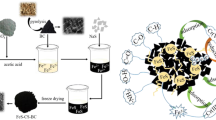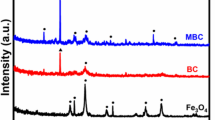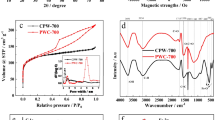Abstract
Novel magnetic carbonaceous bio-char was hydrothermal prepared from microalgae under different loadings of iron and its structures and surface chemistry were characterized with Fourier transform infrared (FTIR), X-ray photoelectron spectroscopy (XPS), scanning electron microscopy (SEM), and nitrogen adsorption-desorption isotherm (BET). The morphology of bio-char changed from sheet to particle as iron loading increased and its surface area also increased. When 3.0 g of dried microalgae and 6.0 mmol iron salt ((NH4)2SO4·FeSO4·6H2O) were mixed and treated, the obtained bio-char possessing the highest amount of oxygen-containing functional groups resulted in the best adsorption performance on tetracycline (TC). This adsorption process was fitted to Langmuir adsorption isotherm and the maximum adsorption capacity was 95.86 mg/g, which is higher than other bio-char reported. The iron loading contributed to the higher adsorption capacity of bio-char, which may be due to three factors, the high surface area, more hydrogen bonding, and bridging effects of the structural Fe for TC. Our data suggest that bio-char may have more important role in stabilization of pollutants in the environment.






Similar content being viewed by others
References
Alexy R, Kumpel T, Kummerer K (2004) Assessment of degradation of 18 antibiotics in the closed bottle test. Chemosphere 57:505–512
Almeida D, Dos Santos HF, Zerner MC (1998) A theoretical study of the interaction of anhydrotetracycline with Al(III). J Pharm Sci 87:1101–1108
Bai J, Liu YB, Li JH, Zhou BX, Zheng Q, Cai WM (2010) A novel thin-layer photoelectrocatalytic (PEC) reactor with double-faced titaniananotube arrays electrode for effective degradation of tetracycline. Appl Catal B Environ 98:154–160
Camillo F, Fernando PC, Florence B, Christel G, Guillaume L, Titirici MM (2011) Hydrothermal carbon from biomass: structural differences between hydrothermal and pyrolyzed carbons via 13C solid state NMR. Langmuir 27:14460–14471
Chen WR, Huang CH (2010) Adsorption and transformation of tetracycline antibiotics with aluminum oxide. Chemosphere 79:779–785
Chen B, Chen Z, Lv S (2011a) A novel magnetic bio-char efficiently sorbs organic pollutants and phosphate. Bioresour Technol 102:716–723
Chen H, Luo HJ, Lan YC, Dong TT, Hua BJ, Wang YP (2011b) Removal of tetracycline from aqueous solutions using polyvinylpyrrolidone (PVP-K30) modified nanoscale zero valent iron. J Hazard Mater 192:44–53
Choi KJ, Kim SG, Kim SH (2008) Removal of antibiotics by coagulation and granular activated carbon filtration. J Hazard Mater 151:38–43
Cui X, Antonietti M, Yu SH (2006) Structural effects of iron oxide nanoparticles and iron ions on the hydrothermal carbonization of starch and rice carbohydrates. Small 2:756–759
Demirbas A, Demirbas MF (2011) Importance of algae oil as a source of biodiesel. Energy Convers Manag 52:163–170
Derylo-Marczewsk A, Buczek B, Swiatkowski A (2011) Effect of oxygen surface groups on adsorption of benzene derivatives from aqueous solutions onto active carbon samples. Appl Surf Sci 257:9466–9472
Figueroa RA, Leonard A, Mackay AA (2004) Modeling tetracycline antibiotic sorption to clays. Environ Sci Technol 38:476–483
Gao Y, Li Y, Zhang L, Huang H, Hu JJ, Shah SM, Su XG (2012) Adsorption and removal of tetracycline antibiotics from aqueous solution by graphene oxide. J Colloid Interface Sci 368:540–546
Gustafsson, Bucheli TD, Kukulska Z, Andersson M, Largeau C, Rouzaud JN, Reddy CM, Eglinto TI (2001) Evaluation of a protocol for the quantification of black carbon in sediments. Glob Biogeochem Cycles 15:881–890
Jeong J, Song W, Cooper WJ, Jung J, Greaves J (2010) Degradation of tetracycline antibiotics: mechanisms and kinetic studies for advanced oxidation/reduction processes. Chemosphere 78:533–540
Ji L, Chen W, Duan L, Zhu D (2009) Mechanisms for strong adsorption of tetracycline to carbon nanotubes: a comparative study using activated carbon and graphite as adsorbents. Environ Sci Technol 43:2322–2327
Ji L, Shao Y, Zheng S, Zhu D (2010) Adsorption of monoaromatic compounds and pharmaceutical antibiotics on carbon nanotubes activated by KOH etching. Environ Sci Technol 44:6429–6436
Ji L, Wan Y, Zheng S, Zhu D (2011) Adsorption of tetracycline and sulfamethoxazole on crop residue-derived ashes: implication for the relative importance of black carbon to soil sorption. Environ Sci Technol 45:5580–5586
Kang J, Liu HJ, Zheng YM, Qu JH, Chen JP (2010) Systematic study of synergistic and antagonistic effects on adsorption of tetracycline and copper onto a chitosan. J Colloid Interface Sci 344:117–125
Li ZH, Schulz L, Ackley C, Fenske N (2010) Adsorption of tetracycline on kaolinite with pH-dependent surface charges. J Colloid Interface Sci 351:254–260
Liu WJ, Zeng FX, Jiang H, Zhang XS (2011) Preparation of high adsorption capacity bio-chars from waste biomass. Bioresour Technol 102:8247–8252
Liu P, Liu WJ, Jiang H, Chen J, Li WW, Yu HQ (2012) Modification of bio-char derived from fast pyrolysis of biomass and its application in removal of tetracycline from aqueous solution. Bioresour Technol 121:235–240
Miao XS, Bishay F, Chen M, Metcalfe CD (2004) Occurrence of antimicrobials in the final effluents of wastewater treatment plants in Canada. Environ Sci Technol 38:3533–3541
Pils JRV, Laird DA (2007) Sorption of tetracycline and chlortetracycline on K- and Ca-saturated soil clays, humic substances, and clay humic complexes. Environ Sci Technol 41:1928–1933
Schmitt H, Stoob K, Hamscher G, Smit E, Seinen W (2006) Tetracyclines and tetracycline resistance in agricultural soils: microcosm and field studies. Microb Ecol 51:267–276
Sithole BB, Guy RD (1987) Models for tetracycline in aquatic environments. Water Air Soil Pollut 32:303–314
Storteboom H, Arabi M, Davis JG, Crimi B, Pruden A (2010) Tracking antibiotic resistance genes in the South Platte River basin using molecular signatures of urban, agricultural, and pristine sources. Environ Sci Technol 44:7397–7404
Titirici MM, Antonietti M (2010) Chemistry and materials options of sustainable carbon materials made by hydrothermal carbonization. Chem Soc Rev 39:103–116
Wang Y, Jia D, Sun R, Zhao H, Zhou D (2008) Adsorption and cosorption of tetracycline and copper (II) on montmorillonite as affected by solution pH. Environ Sci Technol 42:3254–3259
Wang LL, Lg Y, Li Y, Zhang Y, Ma X, Ye Z (2010a) Study on adsorption mechanism of Pb(II) and Cu(II) in aqueous solution using PS-EDTA resin. Chem Eng J 163:364–372
Wang LL, Guo YP, Zhu YC, Li Y, Qu YN, Rong CG, Ma XY, Wang ZC (2010b) A new route for preparation of hydrochars from rice husk. Bioresour Technol 101:9807–9810
Wang YJ, Sun RJ, Xiao AY, Wang SQ, Zhou DM (2010c) Phosphate affects the adsorption of tetracycline on two soils with different characteristics. Geoderma 156:237–242
Wessels JM, Ford WE, Szymczak W, Schneider S (1998) The complexation of tetracycline and anhydrotetracycline with Mg2+ and Ca2+: a spectroscopic study. J Phys Chem B 102:9323–9331
Wu Z, Li W, Webley PA, Zhao D (2012) General and controllable synthesis of novel mesoporous magnetic iron oxide@carbon encapsulates for efficient arsenic removal. Adv Mater 24:485–491
Yang WB, Zheng FF, Lu YP, Xue XX, Li N (2011) Adsorption interaction of tetracyclines with porous synthetic resins. Ind Eng Chem Res 50:13892–13898
Yu SH, Cui XJ, Li K, Yu B, Antonietti M, Colfen H (2004) From starch to metal/carbon hybrid nanostructures: hydrothermal metal-catalyzed carbonization. Adv Mater 16:1636–1840
Zhao YP, Geng JJ, Wang XR, Gu XR, Gao SX (2011) Tetracycline adsorption on kaolinite: pH, metal cations and humic acid effects. Ecotoxicology 20:1141–1147
Acknowledgements
This project was supported by the Postdoctoral Science Foundation of Central South University. For the financial support we are grateful to the National Natural Science Foundation of China (no. 21007014), the National Environmental Protection Public Welfare Program (no. 201009047), Natural Science Foundation of Hunan Province (13JJ04068) and Changsha City Science and Technology Project (K1301103-11).
Author information
Authors and Affiliations
Corresponding authors
Additional information
Responsible editor: Bingcai Pan
Electronic supplementary material
Below is the link to the electronic supplementary material.
ESM 1
(DOC 928 kb)
Rights and permissions
About this article
Cite this article
Peng, L., Ren, Y., Gu, J. et al. Iron improving bio-char derived from microalgae on removal of tetracycline from aqueous system. Environ Sci Pollut Res 21, 7631–7640 (2014). https://doi.org/10.1007/s11356-014-2677-2
Received:
Accepted:
Published:
Issue Date:
DOI: https://doi.org/10.1007/s11356-014-2677-2




